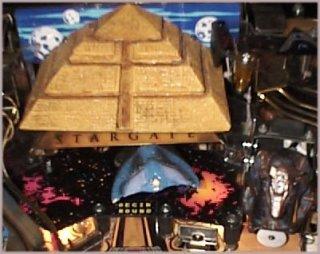


| Arena | Central Park | Control Tower | Doodlebug | Star Trek: The Next Generation |
| Stargate | Virginia | Old Fashion (pachinko) | Bite Monster (Pacman) | Other Links |
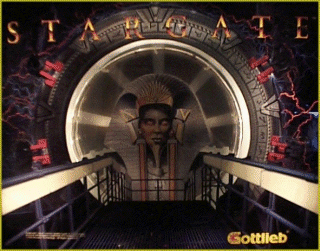
This pinball is based on the film, although it doesn't use voices or matrix images of the stars.
It's a bit disappointing in that respect, the occasional quote would have made it much more fun.
The voice that is used gets annoying fast, repeating "Shoot the pyramid!" and "Shoot the Sarcophogas!" far too often.
The music is adequate but not particularly evocative of the film.

The game features several cute toys including a pyramid that will occasionally rise up off its base, releasing a glider that sways back and forth over the pyramid entrance.
Models of guards wearing their "Horus" masks protect two lane entrances.
Hitting a guard will raise him off the playfield temporarily, allowing a subsequent shot to score.
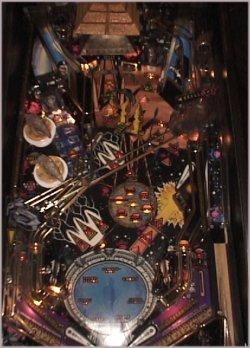
There are 7 basic "shots" to make (e.g. "Transporter" is the left loop, behind a guard). Each of these shots is rewarded by a chevron "locking in" on the matrix display. There are also 7 multiball modes (up to 4 balls simultaneously), usually initiated by a shot into the narrow pyramid entrance.
The skill shot involves plunging the ball just enough to fall on a habitrail and roll past the first exit (which would drop it at the lower right flipper). A successful skill shot drops the ball into the sarcophogas to the left of the left outlane, where it is autoplunged onto the playfield.
Although this is definitely a modern pinball (digitized film snippets, habitrails, etc.) it plays more like a classic machine. It is a simpler game than Star Trek: The Next Generation, for instance. The objectives are uncomplicated with shots ranging from extremely easy to fairly challenging. For example, the pyramid entrance (an important shot) can be reached off any of the 3 flippers, but isn't particularly easy from any of them.
The frequent multiballs really make this game worthwhile.
You hit at least one multiball per game and you can usually get several.
Most are "add-a-multiball", where making the appropriate shot brings another ball into play.
This is a fun machine and doesn't seem to intimidate first-timers like many of the other modern machines do.
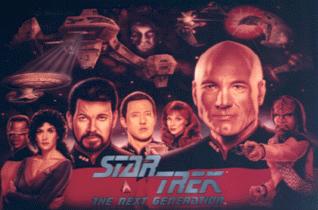
This is a supercool 1-4 player machine with the voices of the original cast (sans Wesley and Tasha).
It features 8 "missions"
(e.g. "Q's Challenge", where Q selects targets for you to hit then taunts you if you miss),
a few "holodeck" simulations (where the pinball pauses and you play a matrix video game)
and Ferengi-, Romulan-, Cardassian- and Borg-themed multi-ball modes (e.g., hitting targets
corresponding to the position of Romulan warbirds that decloak on the matrix screen).
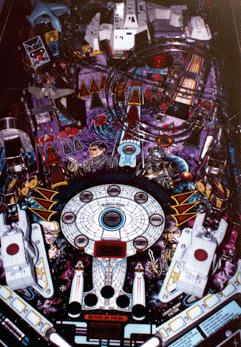
The authentic musical score and dialog adds much to the feel of the game. For example, when you lock a ball for the first time an admiral appears on the matrix display and orders the Enterprise to intercept a Borg ship. When the second ball locks, Worf reports an unknown object, Picard demands it "on screen" and the Borg ship suddenly zooms in. When the 3rd ball locks, the machine darkens as a playfield model of a Borg ship illuminates and several Borg appear on the matrix display demanding "assimilation". Picard refuses, Ryker calls "Battle Stations", dramatic music swells and suddenly 3 balls are flying (some are shot directly out of the Borg ship). You must divide your attention between targets that simulate phaser and photon torpedo volleys and a spinner that refreshes your shields. Successful shots are congratulated and damage reports keep you aware of how well the Borg are doing.
The game includes some great custom quotes. Q has several sarcastic comments should the ball drain during his mission such as "Oh, and you were doing so well.") Data occasionally observes (after a mission has been completely botched) "Had you propelled the ball along the proper trajectory, you would have been rewarded."
The missions are themed fairly well and there is enough variety to make repeated playings worthwhile. A special 6-ball multiball mission that can only be reached after all others have been attempted and a couple hidden modes and "easter eggs" make this a game that can still hold surprises even after months of daily play.
In fact, a year after I had the machine I was convinced that the rumoured "Secret Breakout Game"
didn't exist. The FAQ for the pinball was vague on the subject, and I've seen a number of people
asking about it in vain on the rec.games.pinball newsgroup.
Then one night recently I saw Breakout on the "attract mode" display when no one was touching the machine.
I don't know what triggered it, and haven't seen it since. Now that I've seen the graphics, I'm certain
that the game is hidden in there somewhere. I just have to find it.

This pinball features a small spiral "arena" feature in the upper right playfield that is a throwback to the precursor to pinballs. You try to plunge and nudge so the ball will fall into the highest scoring hole. The ball then drops onto the playfield which is a more conventional machine, but some shots will allow the ball to drop back to the plunger to provide another shot onto the "arena".

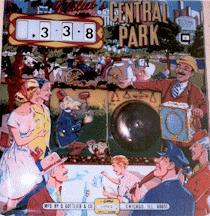
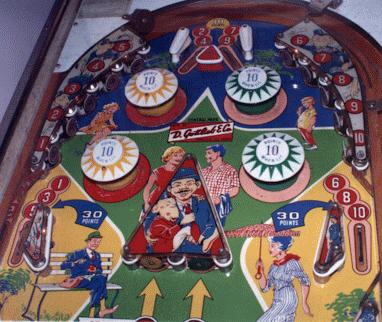
A 3 or 5 ball single player game, illustrated by Art Stenholm.
Score reels display 000-999 (a thousands digit lights for scores 1000-1999).
Every hundred points, the monkey with the mallet rings the brass bell.
An "add-a-ball" version of this game was also produced called "Hurdy-Gurdy".
This replaced the thousands light with an additional score reel, allowing for the larger
scores likely with add-a-ball play.
Description: Completing top targets 1-5 advances the yellow bonus, 6-10 advances the green bonus, hitting a central target collects the corresponding bonus. Various roll-overs "give" you 2 or 3 targets (e.g. the right side rollover spots you 6, 8 and 10). The 2,4,7 and 9 targets also light the nearest bumper (increasing it from 1 to 10 points).
On the Hurdy-Gurdy variation of the game, the top rollovers light the bumpers and the
bottom center rollovers score the yellow or green bonus
(instead of scoring targets 1,3,5 or 6,8,10).
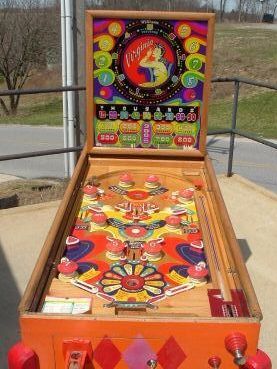
This was one of the very first pinball machines to feature electronic flippers (several earlier machines had mechanically operated bats). The score is displayed via various values that light up on the backglass, and you add them together to get your score. The ball is plunged onto the field and you jostle the table to get it into scoring areas, using the "zipper" flippers to nudge it a little higher.
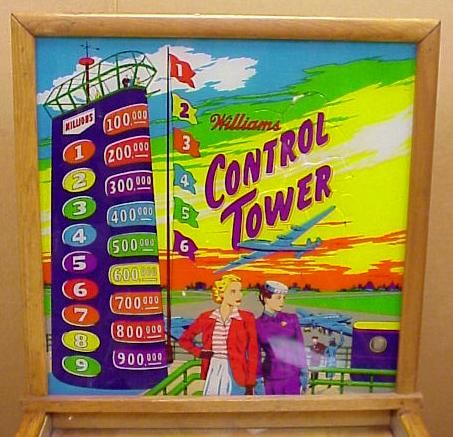
This is an Air Traffic Control themed pinball from the early fifties. I had seen it mentioned in a book on pinball and mentioned somewhere online that I'd like to find one someday.
Memories come and go, but the internet is forever -- years later I was contacted out of the blue by someone looking to sell one. They'd had it in the basement and when they decided to get rid of it, they did a web search and my little note popped out at them.
I was more than happy to give it a new home.

This Pachinko machine features a puppet-like penny-farthing bicycle rider and artwork depicting euro-style buildings and a double decker bus.
Small balls are shot with player-controlled force clockwise around the rim into the vertical playfield where they bounce between the pins as they drop. The goal is to win balls back by dropping them into the "scoops", which release 8-16 balls.
The scoops at the bottom (numbered 1 or 2) cause the pink flaps on each side of the bike rider to open for a second, allowing balls inside the spokes.
Each ball that falls into this chamber releases more balls and has a chance of triggering a jackpot, where the arms keep opening for over a minute allowing big payoffs.
In Japan, a player would purchase a packet of the balls to play and could cash in any winnings for prizes (sometimes cash).
Click on the picture for more info on Pachinko.
This is the original Japanese version of Pacman (they changed the name when it was released in the USA so that vandals wouldn't scratch the "P" into an "F"). It features the original, more difficult maze but the Pacman ROM image had been replaced with one containing a Popeye head.
This model is a cocktail-table video game, with a monitor beneath the tabletop
and the controls just under the edge on both sides. During a 2 player game,
the display image flips toward the current player.
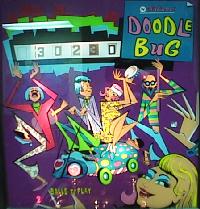
We had a Williams' Doodlebug (1971) pinball machine visiting with us for a few days en route to a new home. It's extremely addictive and we were sorry to see it leave.
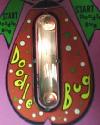 Description: Doodlebug is a configurable (add-a-ball or replay) game with
a unique mechanism that sometimes makes a "captive" pinball bash back and forth
several times per second in a slot beneath a playfield window, scoring points with each lap.
The tricky part is, almost anything the regular pinball hits will stop the "bug".
The doodlebug starts off at 10 points per lap, but hitting 4 targets in order multiplies
this by 10 (up to 10,000!).
Description: Doodlebug is a configurable (add-a-ball or replay) game with
a unique mechanism that sometimes makes a "captive" pinball bash back and forth
several times per second in a slot beneath a playfield window, scoring points with each lap.
The tricky part is, almost anything the regular pinball hits will stop the "bug".
The doodlebug starts off at 10 points per lap, but hitting 4 targets in order multiplies
this by 10 (up to 10,000!).
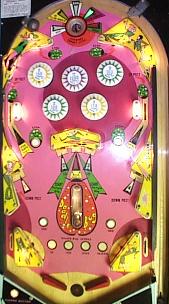
The strategy is therefore:
Years ago the new owner got a Doodlebug up to 10,000 points,
but drained the ball before "doodling" even once.
This incident left a permanent scar on his psyche, and it is sincerely hoped that bringing
home his own machine will help him eventually to a full recovery.
The Internet Pinball Database, home of the pinball database and other references and links.
rec.games.pinball newsgroup, for current info and discussions on pinball collecting and playing.
This is a good place to get your questions answered. As with any newsgroup, please lurk a bit before you post.
 Overkill home page
Overkill home page